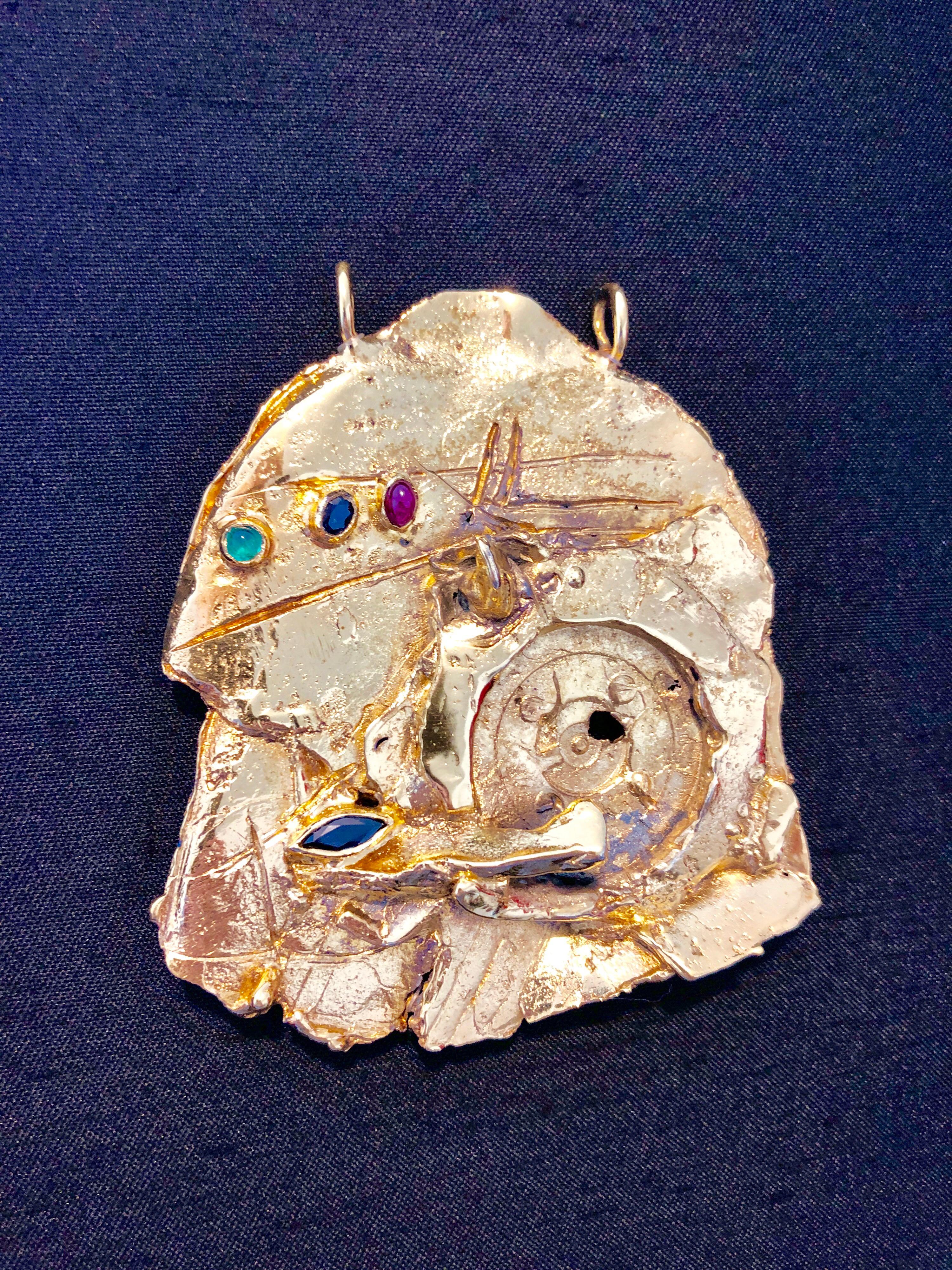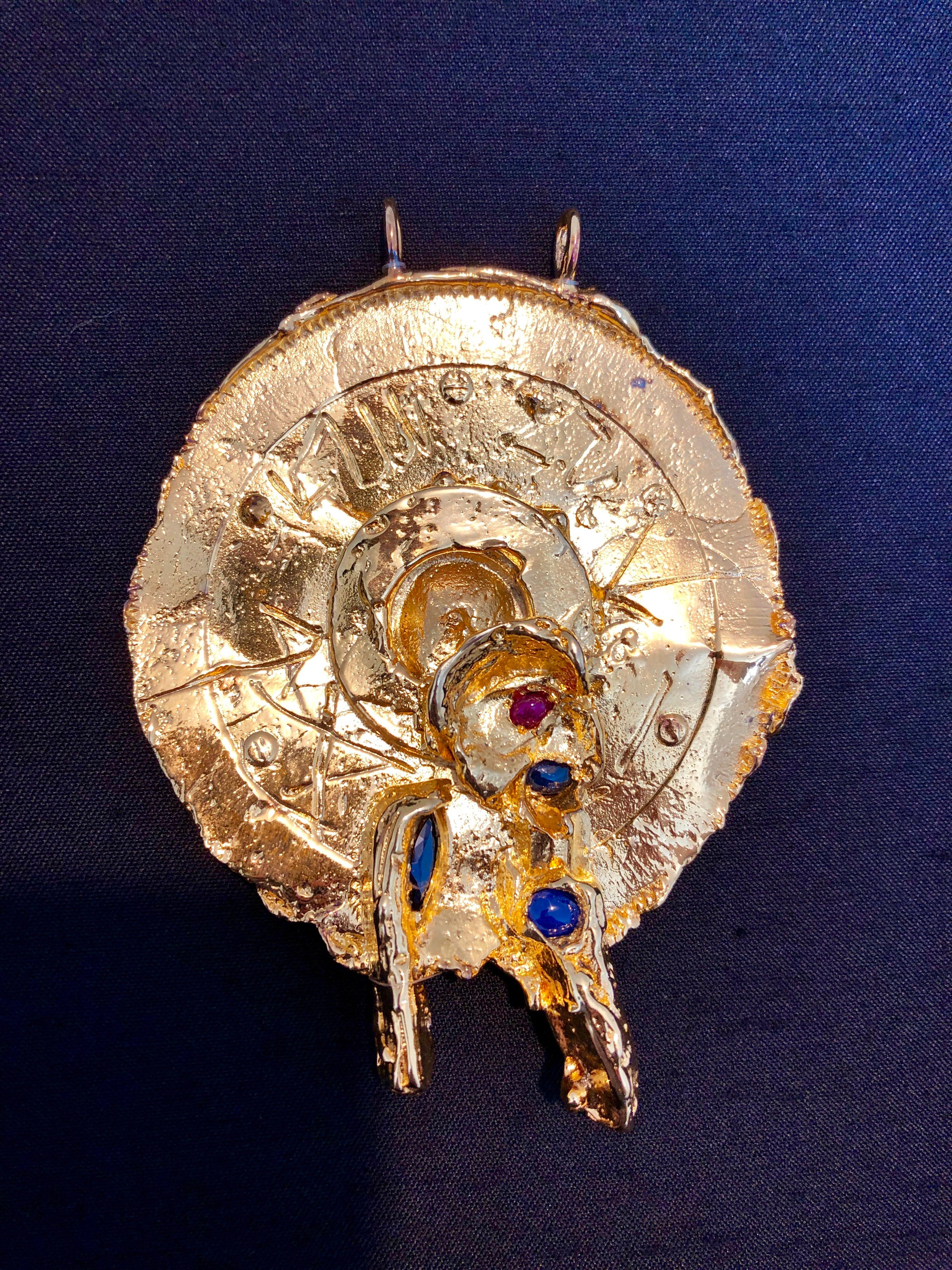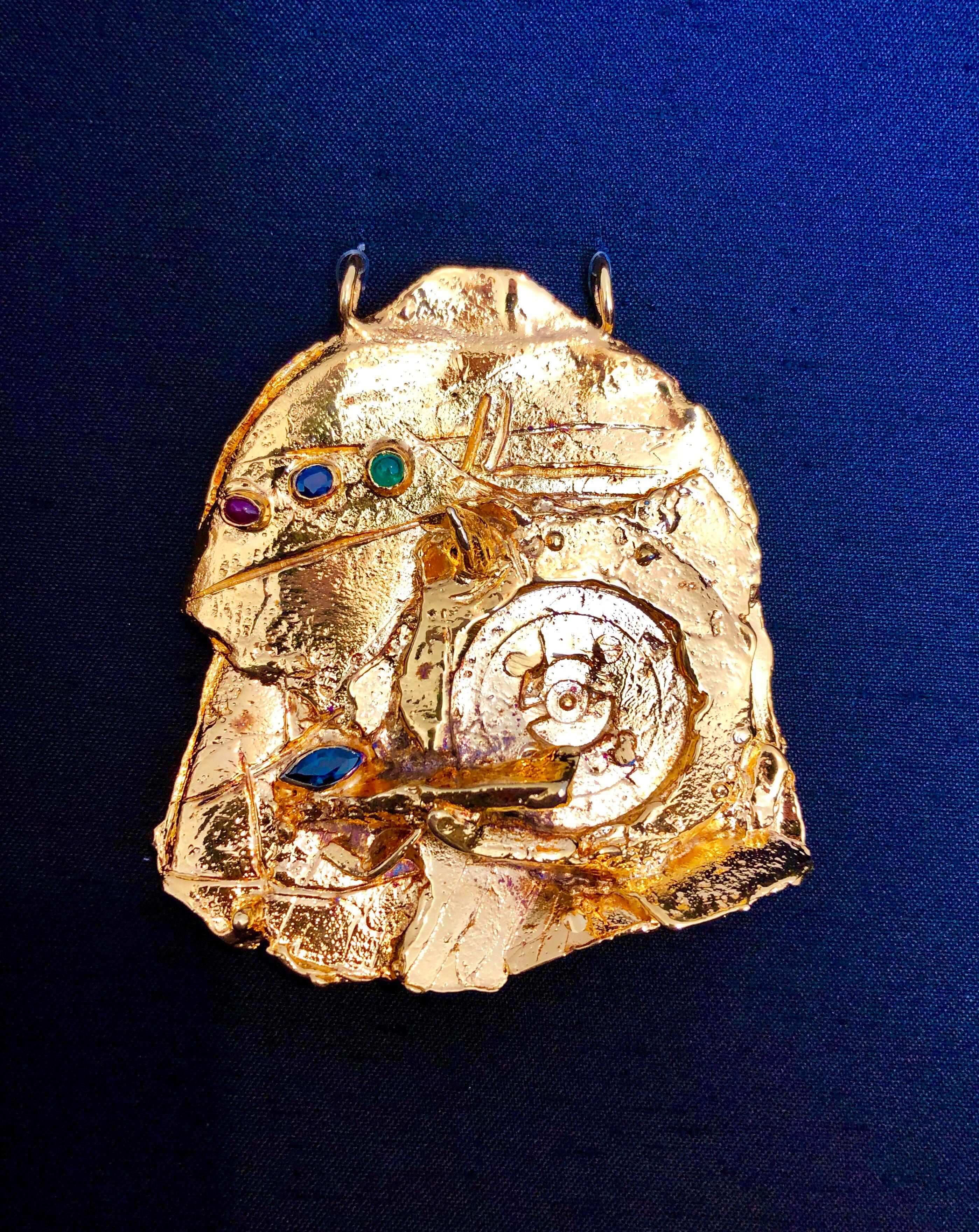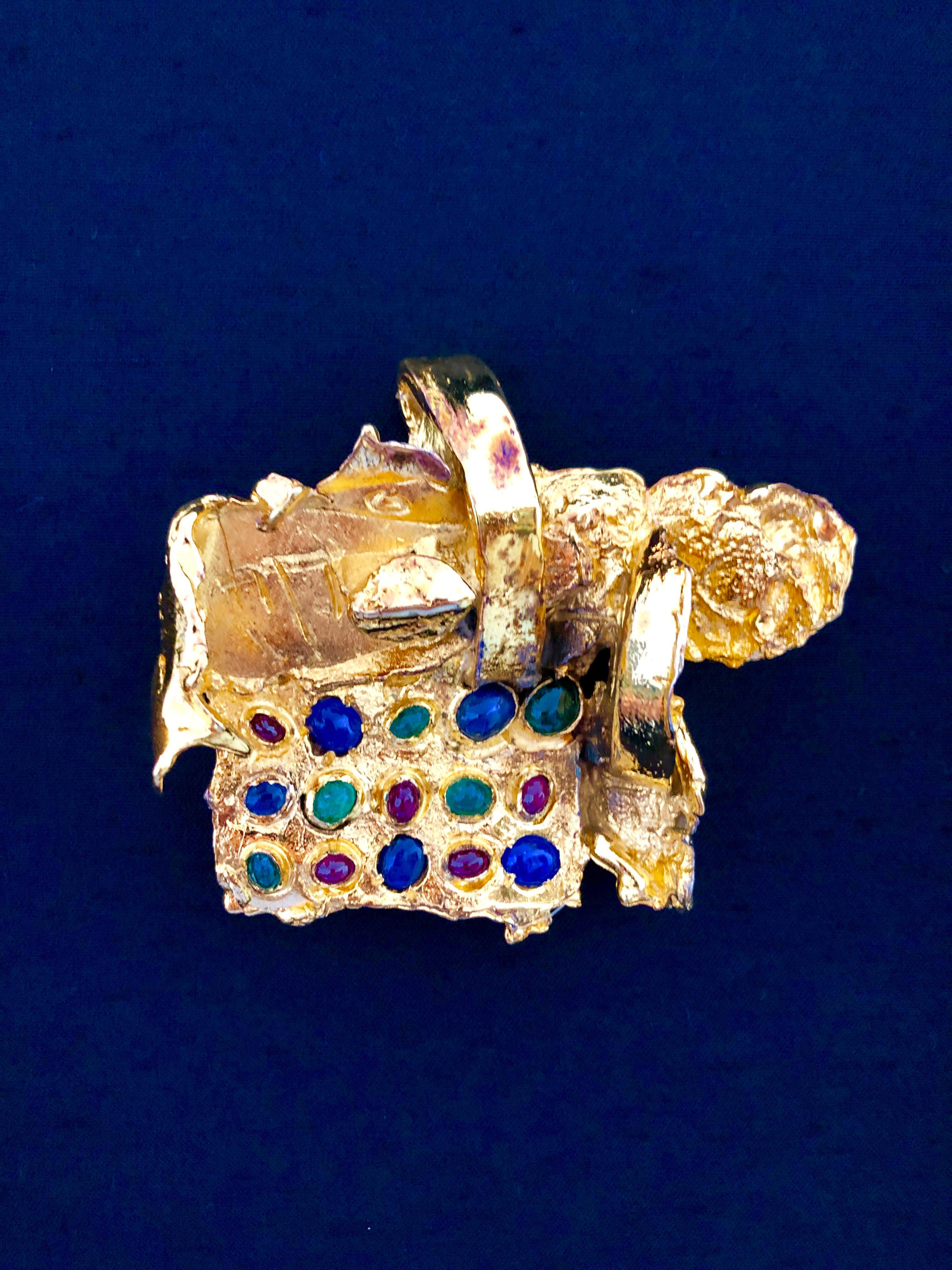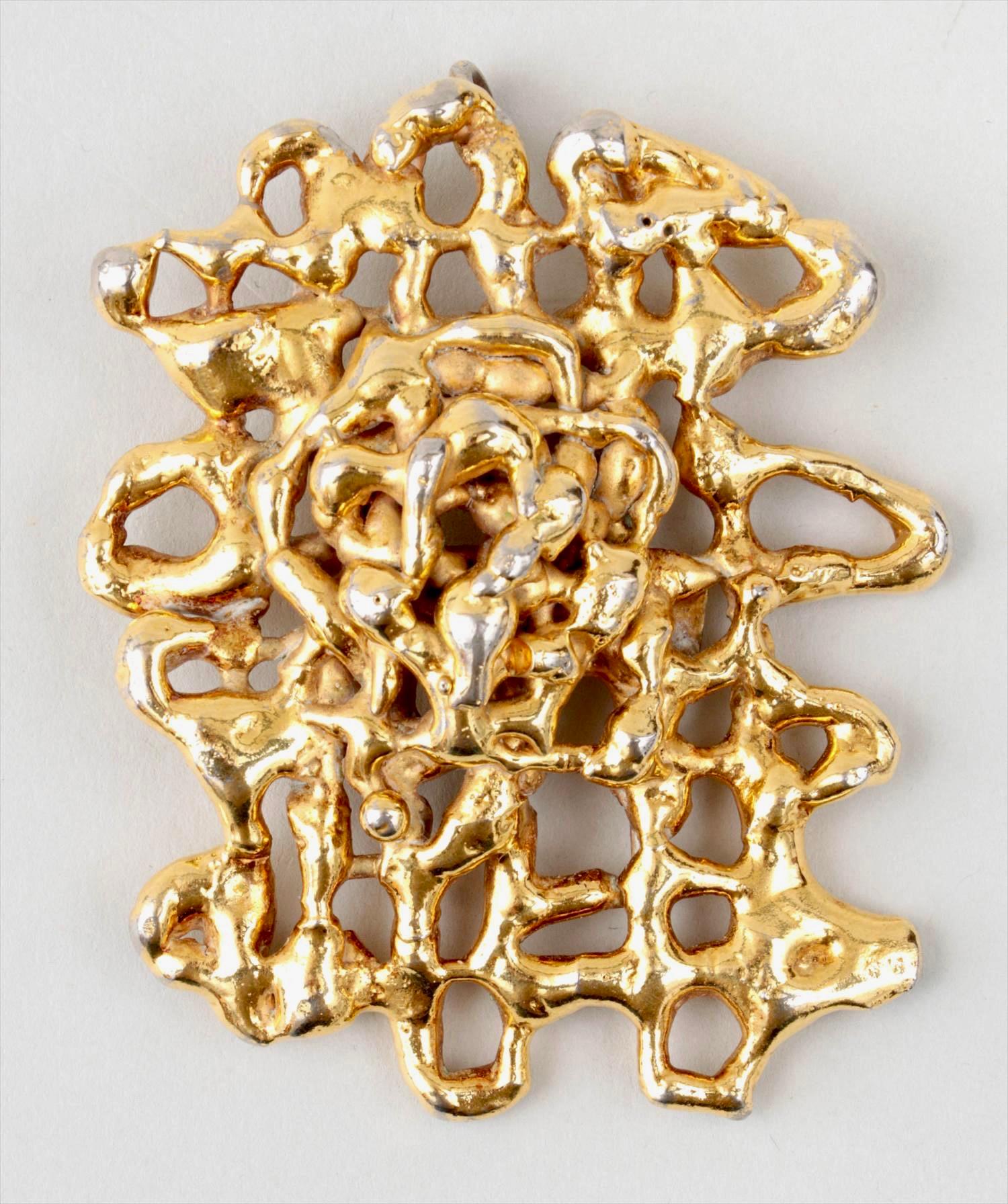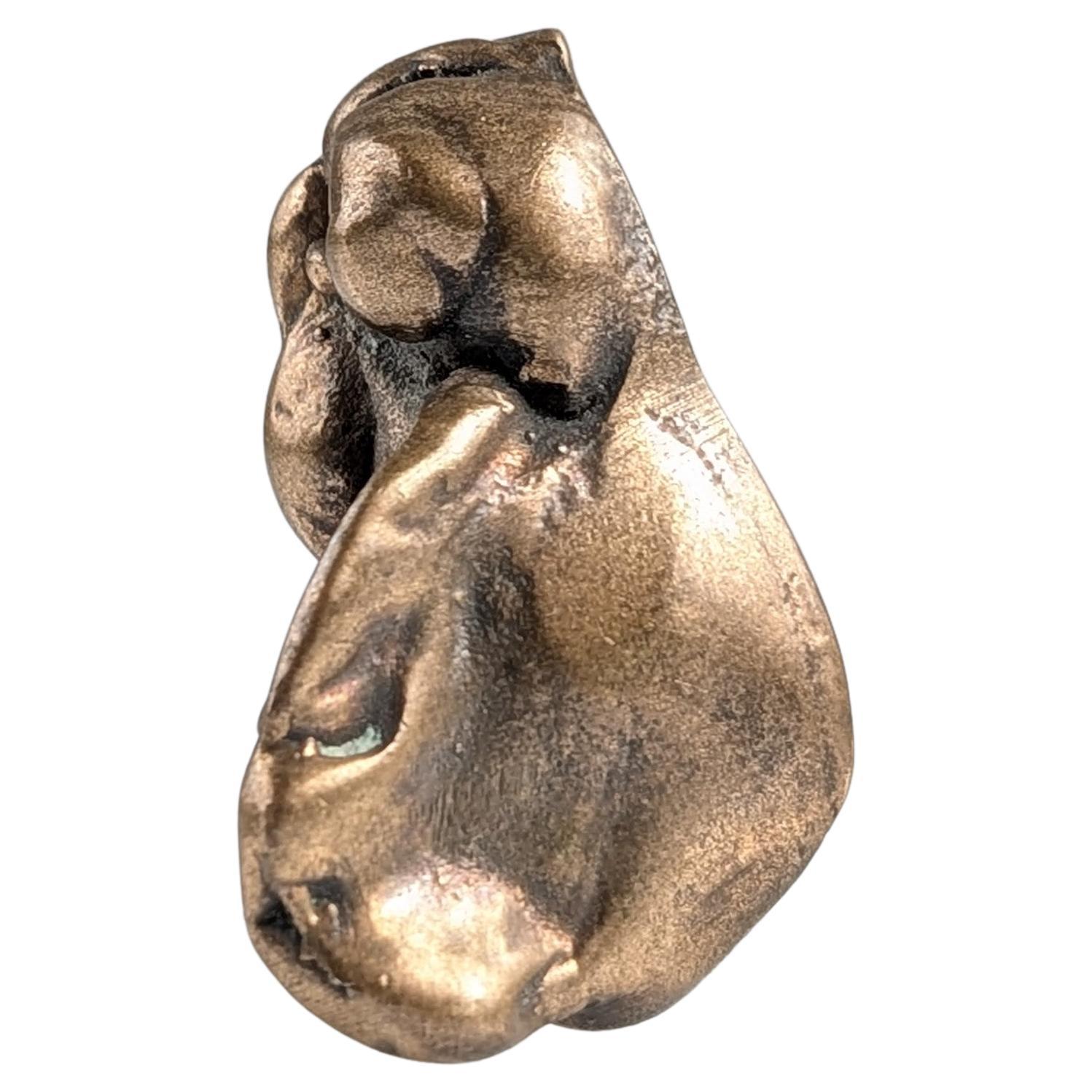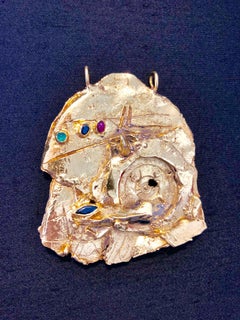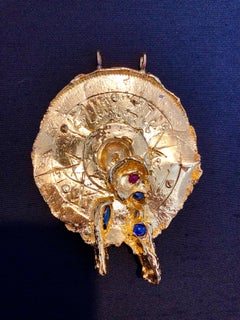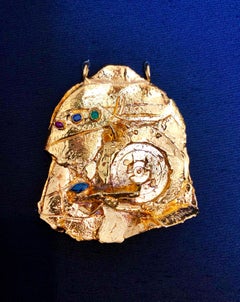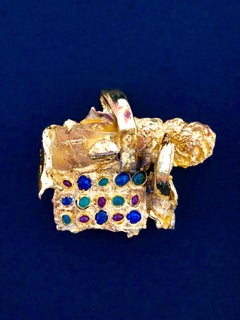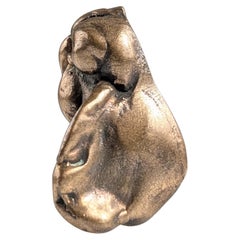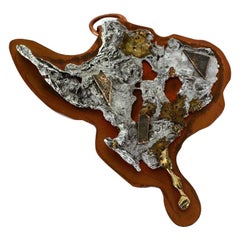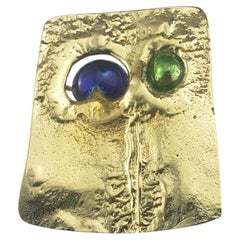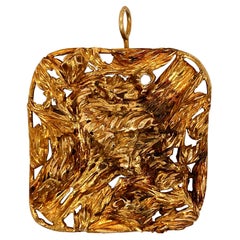Items Similar to Gold Gilt Bronze Sculpture Pendant Israeli Tumarkin Abstract Modernist Jewelry
Want more images or videos?
Request additional images or videos from the seller
1 of 12
Igael TumarkinGold Gilt Bronze Sculpture Pendant Israeli Tumarkin Abstract Modernist Jewelryc.1960s-1970s
c.1960s-1970s
$3,000
£2,277.55
€2,605.03
CA$4,191.44
A$4,661.79
CHF 2,434.24
MX$56,729.03
NOK 31,088.99
SEK 29,155.99
DKK 19,442.34
Shipping
Retrieving quote...The 1stDibs Promise:
Authenticity Guarantee,
Money-Back Guarantee,
24-Hour Cancellation
About the Item
Measures about 4.25 X 2.25 inches. Box frame is 17 X 13 inches. Signed by artist verso. From the literature that I have seen I believe the edition size was limited to 10, I do not know if all 10 were produced. they are not numbered. (Piece is in excellent condition. box frame has some minor wear and piece might need to be remounted, it has been removed and the back taken off for the photograph.)
Abstract Surrealist gold gilt cast bronze wearable art pendant ( it can hang on a necklace or with a pin be worn as a brooch) sculpture (or silver, it is heavy) with precious or semi precious gem stones set into it. This is most probably from the series done with Mayer Swed Jewelers in Tel Aviv. Similar ones with gold gilding and semi precious gemstones from this series have come up at Tiroche auction in Herzliya with estimates from 2500$-3500$ (sold for 3220$ in 2011). This is from the period of the wearable art movement when artists like Alexander Calder, Ibram Lassaw and Clare Falkenstein amongst many others were turning to jewejry as an expressive medium for their art.
Yigal Tumarkin (also Igael Tumarkin) (born 1933) is an Israeli painter and sculptor.
Biography
Peter Martin Gregor Heinrich Hellberg (later Yigal Tumarkin) was born in Dresden, Germany. His father, Martin Hellberg, was a German theater actor and director. His mother, Berta Gurevitch and his stepfather, Herzl Tumarkin, immigrated to Mandate Palestine when he was two. Tumarkin served in the Israeli Navy. After completing his military service, he studied sculpture in Ein Hod, a village of artists near Mount Carmel. Johanaan Peter worked there with Hans Jean Arp and Dada artist Marcel Janco pioneering Modernist studio Jewelry in Israel. Tumarkin did some Jewelry as awards for the state of Israel (along with Yaacov Agam, Jacques Lipchitz, Salvador Dali, Samuel Bak, Dani Karavan and others.) This is not from that edition but much more rare studio produced limited edition sculptural pieces. Among Tumarkin's best known works are the Holocaust memorial in Rabin Square, Tel Aviv and his sculptures commemorating fallen soldiers in the Negev.
Tumarkin is also a theoretician and stage designer. In the 1950s, Tumarkin worked in East Berlin, Amsterdam, and Paris. Upon his return to Israel in 1961, he became a driving force behind the break from the charismatic monopoly of lyric abstraction there. Tumarkin created assemblages of found objects, generally with violent Expressionist undertones and decidedly unlyrical color. Hebrew. His determination to "be different" influenced his younger Israeli colleagues. The furor generated around Tumarkin's works, such as the old pair of trousers stuck to one of his pictures, intensified the mystique surrounding him.Tumarkin has worked extensively in the medium of printmaking, producing over three hundred prints. He was encouraged by the print studios founded during those years in the USA, where prominent artists such as Jasper Johns and Robert Rauschenberg began to engage in printmaking. Tumarkin prints of the sixties were at crossroads between Abstract Expressionism and Pop Art, and between Pop Art and abstract movements that followed. In addition, he was influenced by the Surrealism and Dada movements whose impact was expressed in the combination of free brushstrokes and drip paintings together with the use of such materials as newspaper cuttings, photographs and junk. Tumarkin has participated in various international exhibitions, and won many awards. His works are displayed in private collections and in museums both in Israel and abroad. His work is in many museums and galleries and was included in the show Israel - Entre Reve et Realite at the Musée Juif de Belgique, Brussels, Belgium along with Yosl Bergner, Abel Pann, Reuven Rubin, Igael Tumarkin, Ephraim Moshe Lilien, Yaacov Agam, Jacob Pins and Menashe Kadishman amongst others.
Education
1954 – Studied with Rudi Lehmann, Ein-Hod
1955 Studied with Bertolt Brecht, Berliner Ensemble, Berlin
1955-57 Assistant to the designer Karl von Appen
Awards and recognition
1963 First Prize for Battle of Hulaykat Monument
1968 The Sandberg Prize for Israeli Art, Israel Museum, Jerusalem, Israel
1968 First Prize for Memorial to Sailors, Haifa
1971 First Prize for Memorial for "Holocaust and Resurrection", Tel Aviv
1978 First Prize in the Biennale for Drawing, Reike
1984 Award from the President of the Italian Republic
1985 Dizengoff Prize for Sculpture
1990 Guest of the Japan Foundation
1992 August Rodin Prize, The International Sculpture Competition of the Open Museum, Hakone, Japan, for his sculpture of the sign at the entrance to Auschwitz concentration camp Arbeit Macht Frei.
1997 Award of Excellence, the President of the Federal Republic of Germany
1998 Sussman Prize, Vienna
2004 Israel Prize for sculpture
- Creator:Igael Tumarkin (1933, German, Israeli)
- Creation Year:c.1960s-1970s
- Dimensions:Height: 17 in (43.18 cm)Width: 13 in (33.02 cm)Depth: 2 in (5.08 cm)
- Medium:
- Movement & Style:
- Period:
- Condition:the piece is good. frame is included and might have some minor wear and need remounting.
- Gallery Location:Surfside, FL
- Reference Number:1stDibs: LU38214363902
About the Seller
4.9
Platinum Seller
Premium sellers with a 4.7+ rating and 24-hour response times
Established in 1995
1stDibs seller since 2014
1,784 sales on 1stDibs
Typical response time: <1 hour
- ShippingRetrieving quote...Shipping from: Surfside, FL
- Return Policy
Authenticity Guarantee
In the unlikely event there’s an issue with an item’s authenticity, contact us within 1 year for a full refund. DetailsMoney-Back Guarantee
If your item is not as described, is damaged in transit, or does not arrive, contact us within 7 days for a full refund. Details24-Hour Cancellation
You have a 24-hour grace period in which to reconsider your purchase, with no questions asked.Vetted Professional Sellers
Our world-class sellers must adhere to strict standards for service and quality, maintaining the integrity of our listings.Price-Match Guarantee
If you find that a seller listed the same item for a lower price elsewhere, we’ll match it.Trusted Global Delivery
Our best-in-class carrier network provides specialized shipping options worldwide, including custom delivery.More From This Seller
View AllGold Gilt Bronze Sculpture Necklace Art Israeli Tumarkin Abstract Surrealist
Located in Surfside, FL
Measures about 4 X 3.75 inches. Box frame is 17 X 13 inches. Signed by artist verso. From the literature that I have seen I believe the edition size was limited to 10, I do not know ...
Category
1960s Modern Abstract Sculptures
Materials
Gold, Bronze
Gold Gilt Bronze Sculpture Pendant Art Israeli Tumarkin Abstract Surrealist
Located in Surfside, FL
Measures about 5.25 X 3.75 inches. Box is 17 X 13 inches. Signed by artist verso. From the literature that I have seen I believe the edition size was limited to 10, I do not know if ...
Category
1960s Surrealist Abstract Sculptures
Materials
Gold, Bronze
Gilt Bronze Sculpture Brooch Wearable Art Israeli Tumarkin Abstract Surrealist
Located in Surfside, FL
Measures about 3.75 X 3.5 inches. Box is 11 X 11 inches. (Piece is in excellent condition. box frame has some minor wear and piece might need to be remounted, it has been removed and...
Category
1960s Surrealist Abstract Sculptures
Materials
Gold, Bronze
Gold Gilt Bronze Sculpture Brooch Art Israeli Tumarkin Abstract Surrealist
Located in Surfside, FL
Measures about 4 X 3.75 inches. Box frame is 17 X 13 inches. Signed by artist verso. From the literature that I have seen I believe the edition size was limited to 10, I do not know ...
Category
1960s Modern Abstract Sculptures
Materials
Gold, Bronze
Vintage Abstract Expressionist Ibram Lassaw Modernist Bronze Sculpture Pendant
By Ibram Lassaw
Located in Surfside, FL
IBRAM LASSAW
(Russian-American, 1913-2003),
Sculptural pendant
Gold plated bronze
Signed verso
Measurements: 2-7/8''h, 2-1/4''w.
Ibram Lassaw was born in Alexandria, Egypt, of Russian Jewish émigré parents. After briefly living in Marseille, France, Naples, Italy Tunis, Malta, and Constantinople, Turkey his family settled in Brooklyn, New York, in 1921.His family settled in Brooklyn, New York. He became a US citizen in 1928. Ibram Lassaw, one of America's first abstract sculptors, was best known for his open-space welded sculptures of bronze, silver, copper and steel. Drawing from Surrealism, Constructivism, and Cubism, Lassaw pioneered an innovative welding technique that allowed him to create dynamic, intricate, and expressive works in three dimensions. As a result, he was a key force in shaping New York School sculpture.He first studied sculpture in 1926 at the Clay Club and later at the Beaux-Arts Institute of Design in New York. He made abstract paintings and drawings influenced by Kandinsky, Sophie Taeuber Arp, and other artists. He also attended the City College of New York. Lassaw’s encounter with avant-garde art in the International Exhibition of Modern Art (1926), organized by the Société Anonyme at the Brooklyn Museum, made a powerful impression on him. In the early 1930s he explored new materials and notions of open-space sculpture. The ideas of László Moholy-Nagy and Buckminster Fuller were important to him, and he knew the work of Julio González, Pablo Picasso, and the Russian Constructivists. After experimenting with plaster, rubber and wire, Lassaw began working with steel, which became a frequent medium for the artist, along with other metals. His work reflects the influence of Surrealist artists such as Alberto Giacometti and Joan Miro as well as American Modernist Alexander Calder.A pioneer of abstract sculpture in the United States, in 1936 Lassaw was a founding member of the organization American Abstract Artists. Between 1933 and 1942 he worked for various federal arts projects: the Public Works of Art Project, Civil Works Authority, and WPA, the Works Progress Administration Federal Art Project. In 1938 he produced his first welded work. He served with the U.S. Army, where he learned direct welding techniques. During the 1940s he experimented with cage constructions and with acrylic plastics, adding color to his sculptures by applying dye directly to their surfaces. In 1949 Lassaw was a founder of the Club, an informal discussion group of avant-garde artists that had developed from gatherings at his studio, on Eighth Street.
During the mid-1930s, Lassaw worked briefly for the Public Works of Art Project cleaning sculptural monuments around New York City. He subsequently joined the WPA as a teacher and sculptor until he was drafted into the army in 1942. Lassaw's contribution to the advancement of sculptural abstraction went beyond mere formal innovation; his promotion of modernist styles during the 1930s did much to insure the growth of abstract art in the United States. He was one of the founding members of the American Abstract Artists group, and served as president of the American Abstract Artists organization from 1946 to 1949. In 1951, Samuel Kootz invited Lassaw to join his gallery in New York. He also had a summer gallery in Provincetown, MA. Lassaw had been summering in Provincetown since 1944, and in 1951 rented an apartment next door to the Kootz Gallery. Among the artists in the Kootz Gallery were Jean Arp, William Baziotes, Georges Braque, Jean Dubuffet, Herbert Ferber, Arshile Gorky, Adolph Gottlieb, David Hare, Hans Hofmann, Fernand Leger, Georges Mathieu, Joan Miró, Robert Motherwell, Pablo Picasso, Pierre Soulages, and Maurice de Vlaminck. Lassaw is a sculptor who was a part of the New York School of Abstract expressionism during the 1940s and 1950s. Jackson Pollock, Lee Krasner, James Brooks, Willem de Kooning, and several other artists like Lassaw spent summers on the Southern Shore of Long Island. Lassaw spent summers on Long Island from 1955 until he moved there permanently in 1963.
SELECT EXHIBITIONS
1961 International Exhibition of Modern Jewelry 1890–1961, organized by the Worshipful Company of Goldsmiths in association with the Victoria and Albert Museum, London
1967 Exhibition of Jewelry by Painters and Sculptors, organized for circulation by MoMA
1973 Jewelry...
Category
Mid-20th Century Abstract Expressionist Abstract Sculptures
Materials
Gold, Bronze
Rare Aharon Bezalel Israeli Gilt Modernist Bronze Sculpture Suite
By Aharon Bezalel
Located in Surfside, FL
The width dimensions are variable. the tallest height is 11.5 inches. Family group. A suite of three bronze sculptures.
Aharon Bezalel (born Afghanistan 1926) Born in Afghanistan in 1926 and immigrated to Israel at an early age. As a youth was engaged as a silversmith and craftsman, and was a student of the sculptor Zev Ben-Zvi from whom he absorbed the basic concepts of classic and modernist art and interpreted, according to them, ideas based on ancient Hebrew sources.
Aharon Bezalel works and resides in Jerusalem, he taught art for many years.
“I saw myself as part of this region. I wanted to find the contact between my art and my surroundings. Those were the first years of Jean Piro’s excavations at the Beer-Sheba mound. They found there, for example, the Canaanite figurines that I especially liked and that were an element that connected me with the past and with this place.” “…a seed and sperm or male and female. These continue life. The singular, the individual alone, cannot exist; I learned this from my father who dabbled with the Kabbalah.”
(Aharon Bezalel, excerpt from an interview with David Gerstein)
“The singular in Aharon Bezalel’s work is always potentially a couple if not a threesome[…] the one is also the many: when the individual is revealed within the group he will always seek a huddling, a clinging together.
The principle of modular construction is required by this perception of unity and multiplicity, as modular construction in his work is an act of conception or defense.
Two poles of unity, potentially alone, exist in A. Bezalel’s world: From a formal, sculptural sense these are the sphere and pillar, metaphorically these are the female in the final stages of pregnancy and the solitary male individual. Sphere-seed-woman; Pillar-strand-man. The disproportional, small heads in A. Bezalel’s figures leave humankind in it’s primal physical capacity. The woman as a pregnancy or hips, the man as an aggressive or defensive force, the elongated chest serves as a phallus and weapon simultaneously.
(Gideon Ofrat)
EIN HAROD About the Museum's Holdings: Israeli art is represented by the works of Reuven Rubin, Zaritzky, Nahum Gutman, Mordechai Ardon, Aharon Kahana, Arie Lubin, Yehiel Shemi, Yosl Bergner and others.
The graphic arts collection contains drawings and graphic works by Pissaro, Modigliani, Pascin, Chagall (almost all of his graphic work), and numerous other artists. The sculpture collection includes works by Jewish sculptors from all over the world including leading Israeli sculptors; Ben Zvi, Lishansky, David Palombo, Yehiel Shemi, Aharon Bezalel and Igael Tumarkin.
Many Jewish sculptors from all parts of the world, beginning with Antokolski, are represented in the collection. In the sculpture courtyard there are works by Chana Orloff, Jacob Epstein (the works he bequeathed to the Museum), Glicenstein, Loutchansky, Constant and Indenbaum from Western Europe; Glid from Yugoslavia; Zorach, Gross and Harkavy from the United States; and most of the outstanding sculptors of Israel : Ben-Zvi, Lishansky, Ziffer, Lehmann, Feigin, Sternschuss, Palombo ( who executed the iron gate...
Category
1970s Expressionist Abstract Sculptures
Materials
Bronze
You May Also Like
Signed Bronze Brutalist Sculpture Pendant 1970s
Located in Benalmadena, ES
This extraordinary brutalist pendant, crafted in bronze, encapsulates the artistic spirit of the 1970s. With an organic and abstract design, the piece reflects a unique sculptural ae...
Category
Vintage 1970s Brutalist Collectible Jewelry
Materials
Bronze
$191 Sale Price
20% Off
1970s Abstract Brass Pendant Style of Pal Kepenyes
By Pal Kepenyes
Located in Chula Vista, CA
1970s pendant mixed metals mounted on a copper plate.
unsigned.
attributed to Pal Kepenyes
H 0.5 in. x W 4.5 in. x D 4.5 in.
Item is preowned vintage condition.
Category
Vintage 1970s Mexican Mid-Century Modern Collectible Jewelry
Materials
Brass
$200 Sale Price
20% Off
Vintage 14K Yellow Gold and Enamel Modernist Abstract Brooch #19668
Located in Washington Depot, CT
Vintage 14K Yellow Gold and Enamel Modernist Abstract Brooch
This beautiful abstract brooch is set in yellow gold and accented with blue and green enamel.
Size: 35 mm x 29 mm
Weig...
Category
20th Century Modern Brooches
Materials
Gold, 14k Gold, Yellow Gold, Enamel
Modernist Gold Brutalist Pendant, C 1960
Located in Cincinnati, OH
Gold Modernist pendant necklace. The 2" x 2" 14K squircular shaped , heavily textured yellow gold pendant with a hinged bale and pin clasp. Inspired by nature of some form, this pendant could relate to the texture of the moon, a close-up of foliage or perhaps the artists rendition of his own inner feelings.
Many studio jewelers of the 60's and early 70's were influenced by not only nature, but grew out of a period of "Abstract Expressionism" that seemed to inform the bold jewelry...
Category
Vintage 1960s American Modernist Pendant Necklaces
Materials
Gold, 14k Gold
1980 Italy Bronze Abstract Sculpture Jiro Sugawara Orizzonte Maschile
By Jiro Sugawara
Located in Brescia, IT
This artwork was created by the artist Jiro Sugawara, the title is "Male horizon"
Jiro Sugawara is a post-war artist and he was born in Japon in 1941. He studied sculpture at the Tok...
Category
Late 20th Century Post-Modern Abstract Sculptures
Materials
Bronze
1980 Italy Bronze Abstract Sculpture Jiro Sugawara Orizzonte Maschile
By Jiro Sugawara
Located in Brescia, IT
This artwork was created by the artist Jiro Sugawara, the title is "Male horizon"
Jiro Sugawara is a post-war artist and he was born in Japon in 1941. He...
Category
Late 20th Century Italian Post-Modern Abstract Sculptures
Materials
Bronze
More Ways To Browse
Vintage Modernist Jewelry
Gold Black Sculpture
Israeli Jewelry
Gem Sculpture
Belgium Stone Art
Pop Art Jewelry
Vintage Semi Precious Stone Jewelry
Bronze Soldier
Modernist Bronze Jewellery
Gilt Bronze Jewelry Box
Vintage Abstract Brooch
Hebrew Jewelry
Vintage Jewelry Vienna
Salvador Dali Bronze
1960s Italian Gold Necklace
1997 Necklace
Vintage Brooch Karl
Israel Silver Jewelry
